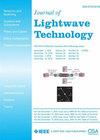Efficient Physics-Informed Neural Network for Ultrashort Pulse Dynamics in Optical Fibers
IF 4.1
1区 工程技术
Q2 ENGINEERING, ELECTRICAL & ELECTRONIC
引用次数: 0
Abstract
Simulating the propagation of ultrashort pulses in optical fibers is vital for photonic technologies such as laser design, high-speed telecommunications, and high-resolution imaging. The conventional approach using the nonlinear Schrödinger equation (NLSE) is time-intensive and complex, creating a hurdle for real-time experimental design and pulse optimization. While recurrent neural networks (RNNs) have been explored to mitigate these issues, they often require extensive NLSE simulations for training, presenting challenges related to time and cost. To overcome these limitations, we propose a physics-informed neural network (PINN) that efficiently captures ultrashort pulse dynamics, reducing the computational burden and the need for extensive training data. We examine the model's applicability for initial pulse widths above and below 1 ps in optical fibers, evaluating its prediction accuracy, training duration, and speed of prediction. Our findings demonstrate that PINN offers a precise and efficient solution for predicting intricate pulse behaviors. With its adaptability to various input conditions and high predictive accuracy even with limited training data, PINN shows great promise for widespread use in experimental settings.光纤超短脉冲动力学的高效物理信息神经网络
模拟超短脉冲在光纤中的传播对于激光设计、高速通信和高分辨率成像等光子技术至关重要。使用非线性Schrödinger方程(NLSE)的传统方法耗时且复杂,为实时实验设计和脉冲优化创造了障碍。虽然已经探索了递归神经网络(rnn)来缓解这些问题,但它们通常需要大量的NLSE模拟来进行训练,这带来了与时间和成本相关的挑战。为了克服这些限制,我们提出了一种物理信息神经网络(PINN),它可以有效地捕获超短脉冲动力学,减少计算负担和对大量训练数据的需求。我们研究了该模型对光纤中高于和低于1ps的初始脉冲宽度的适用性,评估了其预测精度、训练持续时间和预测速度。我们的研究结果表明,PINN为预测复杂的脉冲行为提供了精确而有效的解决方案。由于其对各种输入条件的适应性和即使在有限的训练数据下也具有很高的预测精度,PINN在实验环境中具有广泛的应用前景。
本文章由计算机程序翻译,如有差异,请以英文原文为准。
求助全文
约1分钟内获得全文
求助全文
来源期刊

Journal of Lightwave Technology
工程技术-工程:电子与电气
CiteScore
9.40
自引率
14.90%
发文量
936
审稿时长
3.9 months
期刊介绍:
The Journal of Lightwave Technology is comprised of original contributions, both regular papers and letters, covering work in all aspects of optical guided-wave science, technology, and engineering. Manuscripts are solicited which report original theoretical and/or experimental results which advance the technological base of guided-wave technology. Tutorial and review papers are by invitation only. Topics of interest include the following: fiber and cable technologies, active and passive guided-wave componentry (light sources, detectors, repeaters, switches, fiber sensors, etc.); integrated optics and optoelectronics; and systems, subsystems, new applications and unique field trials. System oriented manuscripts should be concerned with systems which perform a function not previously available, out-perform previously established systems, or represent enhancements in the state of the art in general.
 求助内容:
求助内容: 应助结果提醒方式:
应助结果提醒方式:


